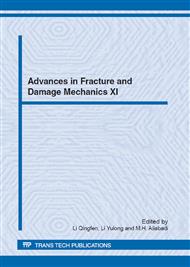p.541
p.545
p.549
p.553
p.557
p.561
p.565
p.569
p.573
Estimation of Shear Behavior of Ultra High Performance Concrete I Girder without Shear Stirrups
Abstract:
Thinner and lighter members can be designed by utilizing the high stiffness and toughness, and high compressive strength of Ultra High Performance Concrete (UHPC), which reaches up to 180MPa. This high strength and ductile tensile behavior of UHPC makes it possible to design the web of the UHPC I Girder without conventional shear stirrups, which makes the UHPC I girder slender, light and economical. However, establishing shear design procedure for UHPC I girders without stirrups requires additional theoretical and experimental studies. This paper investigated shear behavior of UHPC I girder without shear stirrups. The test results show, in spite of no shear stirrups, test specimens have high ductility due to the bridging action of steel fibers against crack opening. UHPC I girders without shear stirrups tested show gradual increase of strength after initial cracking instead of brittle loss of strength as expected from the ordinary reinforced concrete I girders without stirrups. The decrease of the shear span-depth ratio increase the shear strength of the UHPC I girder without stirrups.
Info:
Periodical:
Pages:
557-560
Citation:
Online since:
November 2012
Authors:
Keywords:
Price:
Сopyright:
© 2013 Trans Tech Publications Ltd. All Rights Reserved
Share:
Citation:


